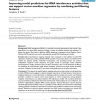Free Online Productivity Tools
i2Speak
i2Symbol
i2OCR
iTex2Img
iWeb2Print
iWeb2Shot
i2Type
iPdf2Split
iPdf2Merge
i2Bopomofo
i2Arabic
i2Style
i2Image
i2PDF
iLatex2Rtf
Sci2ools
BMCBI
2007
2007
Improving model predictions for RNA interference activities that use support vector machine regression by combining and filterin
Background: RNA interference (RNAi) is a naturally occurring phenomenon that results in the suppression of a target RNA sequence utilizing a variety of possible methods and pathways. To dissect the factors that result in effective siRNA sequences a regression kernel Support Vector Machine (SVM) approach was used to quantitatively model RNA interference activities. Results: Eight overall feature mapping methods were compared in their abilities to build SVM regression models that predict published siRNA activities. The primary factors in predictive SVM models are position specific nucleotide compositions. The secondary factors are position independent sequence motifs (N-grams) and guide strand to passenger strand sequence thermodynamics. Finally, the factors that are least contributory but are still predictive of efficacy are measures of intramolecular guide strand secondary structure and target strand secondary structure. Of these, the site of the 5' most base of the guide strand ...
| Added | 08 Dec 2010 |
| Updated | 08 Dec 2010 |
| Type | Journal |
| Year | 2007 |
| Where | BMCBI |
| Authors | Andrew S. Peek |
Comments (0)

